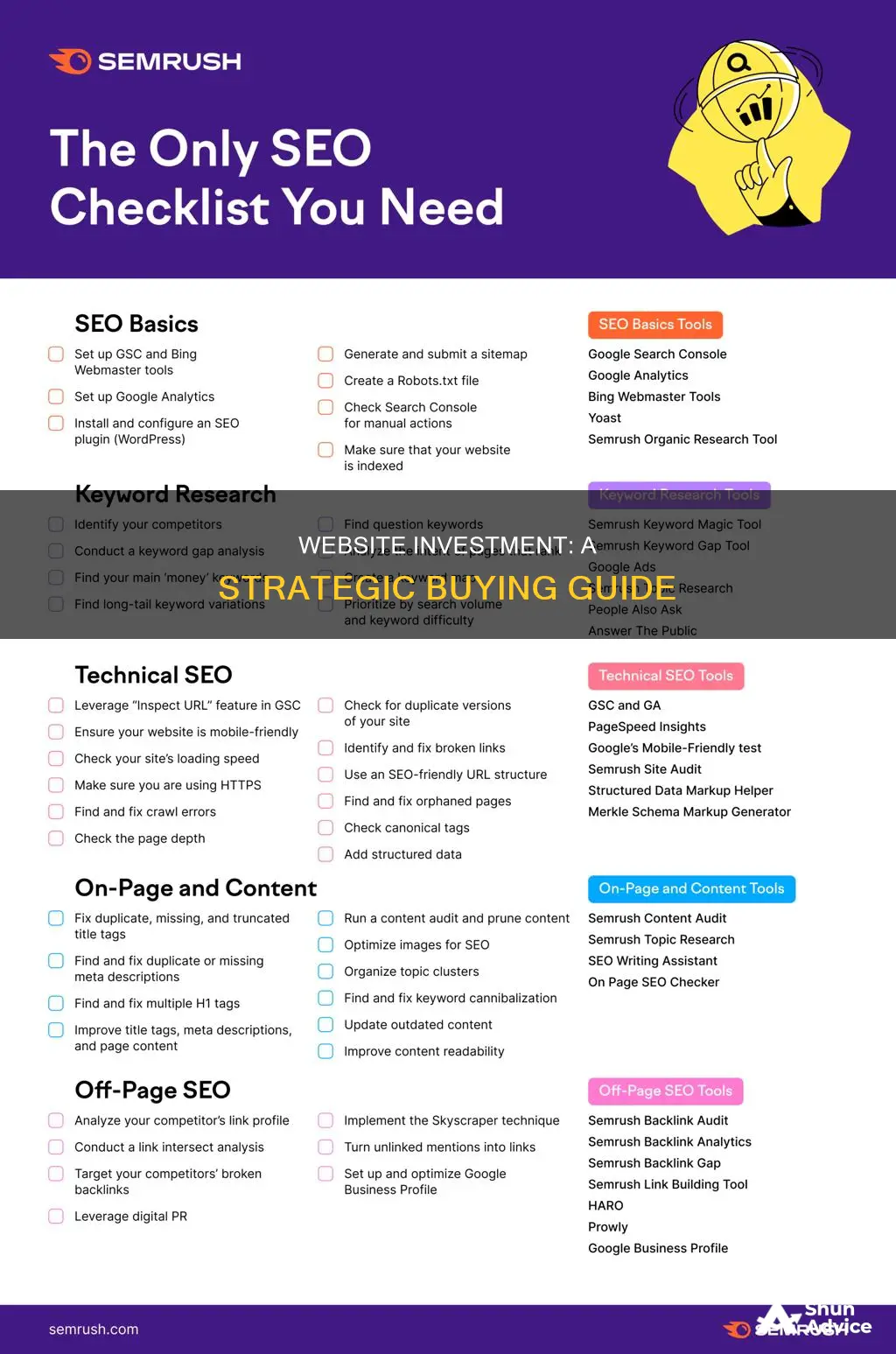
Buying a website is similar to buying a business, and it's a great way to start generating income without the hassle of online platform planning, development, testing, and bug fixing. However, just like any other investment, it's crucial to conduct thorough due diligence before purchasing a website. The process involves checking various aspects of the website to ensure it aligns with your goals and expectations. This includes verifying the website's legitimacy, analysing its traffic, revenue, and financial risks, evaluating the site's SEO health, and assessing the seller's reputation.
What You'll Learn

Domain/site data
The domain zone of the site should be suitable for your purposes. Check that there are no problems with page indexing. If the site is small but there are many pages in the index, it probably has issues with duplicates. While this can be fixed, it is recommended to look for a different solution.
The platform age, rank, link, and content quality are also important. Check the site's SEO performance and how it compares to others in its niche.
Make sure the contact person actually owns the domain. Verify domain registration data and check whom the site is registered to.
Check that the site has no problems in Google Search Console, has a low MOZ Spam Score, and has never been hacked.
When it comes to the analysis of backlinks, it is recommended to get raw data on the total number of backlinks. Check how many of them are dofollow/nofollow links as well as the number of backlinks from .gov/.edu domains.
Use MozTrust, Majestic Trust Flow, Majestic Citation Flow, and Majestic Topical Trust Flow to understand how a particular site is treated by search engines.
Check the website for filters, indexing, and ranking by search engines. Determine if any improvements or fixes are necessary.
ExxonMobil's Infrastructure Overhaul: A $10 Billion Makeover
You may want to see also

Traffic
Monthly Visitor Count and Demographics
Check how many people visit the website each month. This information can be obtained from analytics tools such as Google Analytics or similar platforms. Understanding the number of visitors helps assess the popularity and reach of the website.
Additionally, it is crucial to analyse visitor demographics, including their country of origin, devices used, and time spent on the website. This information provides insights into the target audience and their engagement with the website.
Quality of Traffic
While quantity is important, the quality of traffic is even more critical. Pay close attention to the site's conversion rates to understand how effectively it turns visitors into customers or leads. A low conversion rate may indicate issues with the website's ability to meet its intended purpose.
Analyse the sources of traffic to understand how visitors are reaching the website. Identify the percentage of traffic coming from direct visits, search engines, or other referral sources. A diverse range of traffic sources is generally favourable, as it indicates a broader reach and less reliance on a single channel.
Examine the traffic trends over time to identify any patterns or seasonality. Look for consistent growth or stability in traffic numbers. Be cautious if a website has only recently started receiving steady traffic, as this may not be indicative of long-term performance.
Visitor Behaviour
Study visitor behaviour on the website, including the average session duration, pages visited, and bounce rate. Understanding how visitors interact with the website provides insights into its effectiveness in engaging and retaining users.
Competitor Analysis
Compare the traffic performance of the website against its competitors to identify strengths and weaknesses. Assess the number of direct competitors and their relative strength. If the website you're considering investing in outperforms its competitors, it may be a favourable investment opportunity.
Monitor key performance indicators (KPIs) related to traffic, such as visitor-to-revenue ratio, dwell time, and depth of traffic. These KPIs provide insights into the quality and engagement of the traffic. For example, low dwell time compared to the content length indicates an issue with the website's ability to retain users.
Understand the strategies used to generate traffic, such as search engine optimisation (SEO), content marketing, or paid advertising. Assess the effectiveness of these strategies and consider the potential for future growth or decline in traffic.
In summary, when investing in a website, conduct a comprehensive analysis of its traffic to ensure it attracts a significant number of visitors and has the potential for stable income. By considering the quantity and quality of traffic, traffic sources, trends, and competitor performance, you can make a more informed investment decision.
Best NFT Investment Opportunities
You may want to see also

Income
Actual and Potential Income:
- Assess the current income of the website and its potential for future earnings.
- Examine the various channels and sizes of income, such as affiliate marketing, advertising, memberships, or product sales.
- Understand the payback period and the expected investments needed to maintain and grow the website.
- Calculate the potential income levels and compare them with the investment required and the value you get from owning the website.
Traffic:
- Traffic is crucial for the performance of a website. A stable income is challenging without significant traffic.
- Analyze the number of visitors, their countries of origin, the devices they use, and the time spent on the website.
- While the quantity of traffic is important, focus on quality as well. Monitor site conversion rates and user engagement metrics.
Revenue Sources:
- Identify the existing revenue streams and consider potential additional sources.
- Diversifying income sources can reduce risk and increase overall earnings.
- For example, an affiliate website can benefit from multiple affiliate programs, ads, and display advertising.
Site Performance:
- Evaluate the website's organic traffic and the keywords driving that traffic.
- Understand the short-tail and long-tail keywords, the number of keywords with regular search volume, and the commercial versus non-commercial keywords.
- Ensure the website has a good conversion rate, especially if it's an affiliate site.
- Analyze the depth of traffic, i.e., the number of pages or content pieces that attract visitors.
Competition and Market Position:
- Research the number and strength of direct competitors in the same niche.
- A large number of strong competitors may make a website less attractive for investment.
- Assess the keyword coverage of competitors and identify growth opportunities for the website you plan to buy.
Content Quality and Freshness:
- Ensure the website has high-quality, original, and engaging content.
- Check for duplicate content, which can negatively impact search engine rankings.
- Fresh and regularly updated content tends to perform better, especially for affiliate sites.
- Outdated content may need to be rewritten to remain relevant and factually correct.
Monetization Strategies:
- Understand the website's monetization strategies and their effectiveness.
- Evaluate the use of affiliate links, sponsored posts, advertising, and product sales.
- Consider the potential for additional income streams, such as introducing new products or services.
Remember, a thorough due diligence process is essential when investing in a website. By carefully considering the income-related factors outlined above, you can make a more informed decision about the potential return on your investment.
Cola-Colored Glasses: Coca-Cola's Potential Bet on Aurora
You may want to see also

Seller reputation
When buying a website, it is important to conduct a thorough investigation of the seller's reputation to ensure a secure investment. Here are some detailed guidelines to assess the seller's reputation:
Verify Domain Ownership
It is crucial to confirm that the seller is the legitimate owner of the domain. Request proof of ownership, such as a video of them logging into the domain registrar and displaying the registration details. This ensures that the seller has the authority to sell the domain and prevents any legal issues down the line.
Check Customer Reviews
Research the seller by seeking out customer reviews on dedicated forums or similar platforms. Look for any red flags or recurring issues in their dealings with previous buyers. Be cautious if you notice a pattern of negative feedback, such as failure to fulfil orders, sending incorrect items, or poor after-sales service.
Contact Information and Address
Ensure that the seller provides comprehensive contact information, including a mailing address and telephone number. Verify the address by searching for it on a search engine and comparing it to street views. Be cautious if the address seems unrelated to the nature of the business or is located in an unusual place. Additionally, call the phone number to assess their professionalism and responsiveness.
Verify Domain Registration Data
Check whom the site is registered to and cross-reference this information with the seller's claims. This helps ensure that the seller is transparent and trustworthy.
Request Customer References
If you are dealing with a dedicated software development company, ask them to provide a list of customers who have previously purchased websites from them. Contacting these references can give you valuable insights into the company's track record and the satisfaction of their previous clients.
Site Security and Backlinks
Conduct a comprehensive site security check to ensure that the website has no issues in the Google Search Console, a low MOZ Spam Score, and no history of being hacked. Additionally, analyse the backlinks to the site. Use tools like Ahrefs, Majestic, SEMrush, and Search Console to assess the quality and authority of the backlinks. A large number of low-quality or spammy backlinks can negatively impact the site's reputation and search engine rankings.
Company Reputation
Consider the reputation of the company or seller in the market. A well-established company with a solid guarantee, positive customer feedback, and reliable support (such as 24/7 project maintenance) is more likely to be trustworthy.
Investor Numbers: Who's in the Game?
You may want to see also

Site security
Conduct a Security Audit:
- Perform a comprehensive security audit of the website, including automated vulnerability scanning and manual penetration testing.
- Use tools like Detectify, StackHawk, or AppTrana Basic Scanning to identify potential security issues, such as OWASP Top 10 and SANS Top 25 vulnerabilities.
- Pay close attention to common security risks like SQL injection, cross-site scripting (XSS), and other malicious code injections.
Encryption and Certificates:
- Ensure that the website has a valid and up-to-date SSL certificate.
- Verify that the SSL certificate is trusted by major browsers and uses SHA-256 encryption (not the outdated SHA-1).
- Enable HTTP Strict Transport Security (HSTS) to enforce secure HTTPS communication and protect against stripping attacks.
- Use secure and HTTP-only cookies to protect sensitive information transmitted between the website and its visitors.
Server and Data Security:
- Secure the web server processes by running them with limited privileges. Avoid running as root or Local System.
- Validate and sanitize user inputs to prevent SQL injection and other data-related vulnerabilities.
- Regularly update and patch the website software, CMS, server operating systems, and all other software used to prevent known security holes.
- Restrict physical access to the server and ensure that the firewall blocks all kinds of executable files and unauthorized user inputs.
Protect Against Common Attacks:
- Implement measures to protect against Distributed Denial of Service (DDoS) attacks, such as robust DDoS services, firewalls, and traffic monitoring tools.
- Monitor traffic surges and periodically validate network and application security performance to detect and mitigate potential DDoS attacks.
- Ensure that forms validate input and utilize well-implemented stored procedures to protect against SQL injection attacks.
Additional Considerations:
- Regularly back up the website to safeguard data and ensure business continuity in case of a security breach or data loss.
- Consider using a Web Application Firewall (WAF) to virtually patch application weaknesses and monitor and filter traffic.
- Stay informed about the latest security threats and updates. Subscribe to cybersecurity newsletters and follow reliable security blogs to keep up with emerging vulnerabilities and attack methods.
By following these steps and staying vigilant, you can significantly enhance the security of the website you are investing in and protect it from common cyber threats.
Residential Investment Dividends: Unlocking the Payout Frequency Mystery
You may want to see also
Frequently asked questions
The four main parameters to check are:
- Domain/site data: Check the domain zone and page indexing. Look out for duplicate content issues.
- Traffic: Assess the number of visitors, their countries, devices used, and session duration.
- Income: Consider channels and sizes of income, payback, possible income levels, and expected investments.
- Seller reputation: Verify domain registration data and check customer reviews.
Some other essential aspects to consider include site security and backlinks. Ensure the website has no issues in Google Search Console, has a low MOZ Spam Score, and has never been hacked. Analyse the backlinks using tools like Ahrefs, Majestic, SEMrush, and Search Console.
The price of a website depends on various factors, but it is often determined by:
- Labour costs
- Specialist costs
- Site uniqueness
- Seller's popularity and reputation
- Company's average price rate
It is important to understand the technical structure of the website before purchasing it. Be cautious of expensive content management systems, outdated websites, non-transferable theme and plugin licenses, custom or hacked plugins, and copyright issues.
Due diligence involves checking every aspect of the website to ensure it aligns with what is advertised. This includes basic website information, financial analysis, quantitative and qualitative assessments, and operational considerations.







